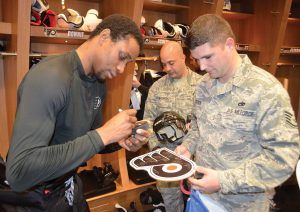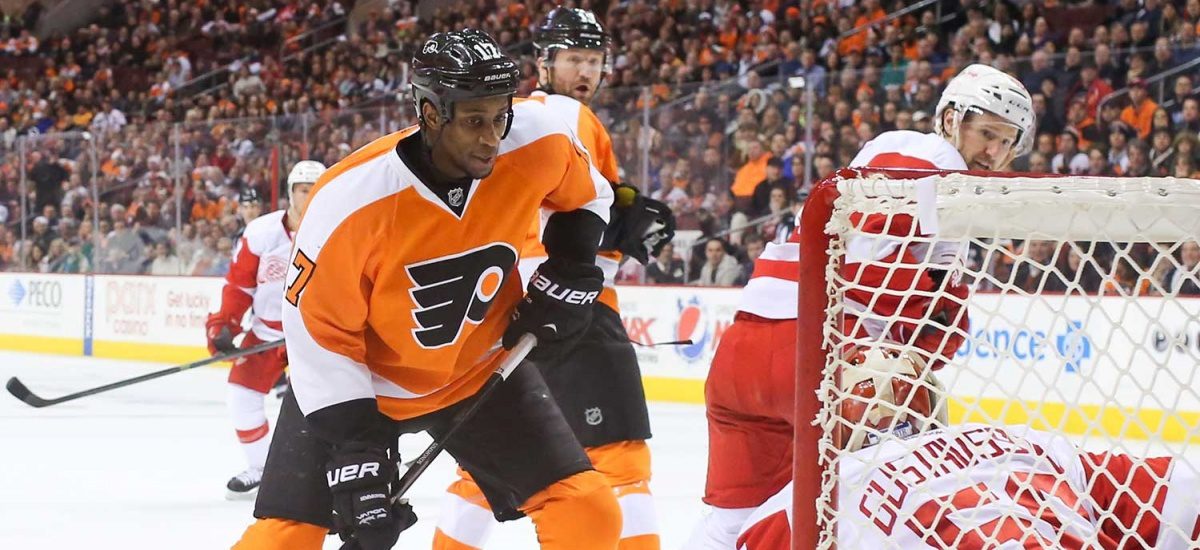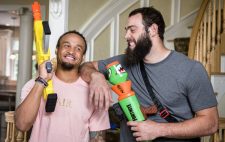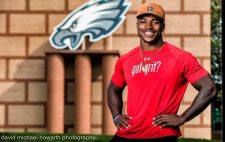If you’d like a taste of the world Flyer Wayne Simmonds lives in, you’ll need to prepare yourself. His life is all about pinpointing what you want, believing you’ll succeed and then doing whatever it takes to get there – including working harder than everyone else.
It’s a lifestyle that has served him well. At 25, Simmonds has steadily improved his game, making coaches notice him and players want to skate alongside him. It’s a world he has built. He dreamed about it as a kid. Then he made it happen.
 Wayne Simmonds tells a story from second grade that sums up pretty well the person – and player – he is.
Wayne Simmonds tells a story from second grade that sums up pretty well the person – and player – he is.
“I had an assignment to write what I wanted my career to be, and I said I wanted to be an NHL player,” he says.
“I got in trouble. The teacher phoned home and told my mom and dad I had to change it, but I refused. I wrote my assignment on hockey, and the teacher wasn’t too happy.
“I would tell everyone I was going to play in the NHL, and they would think I didn’t know what I was talking about because I was just a young kid. But I didn’t let anyone discourage me. It was the NHL or nothing. Luckily, it worked out. I wanted it so bad it came true.”
Simmonds was 20 when he made it to the NHL six years ago. Drafted by the Los Angeles Kings, he was later traded with teammate Brayden Schenn to the Flyers in 2011. The trade was in exchange for then-Flyers captain, Mike Richards, who was popular among Philly fans and considered to be in the prime of his career. Since Simmonds and Schenn were fairly new to the league, Flyer fans weren’t exactly in love with the trade. But they are now.
While Mike Richards has scored seven goals with the Kings this season, Simmonds has scored 18 for the Flyers. He is considered a productive, dependable player; at the beginning of the year, Simmonds had scored goals in nine consecutive games. In January, he scored his 100th goal in the NHL, and 61 of them have been for the Flyers – including one that bounced off his face into the net. He needed seven stitches around his eye and nose. “That one hurt pretty bad,” he says.
Even at 6-foot-2, 183 pounds, Simmonds has had his share of cuts and bruises, but he says it comes with the territory. “We choose hockey, and it’s a rough sport. You know what you’re in for when you sign up. Everyone has bumps and bruises along the way, but it really doesn’t matter. You keep pushing through. It’s a mental thing.”
That “mental thing” is vital when on the ice, Simmonds says. He credits his attitude with being key to his success. “A lot of people out there are skilled, but if you’re not willing to work for it, you’re not going to shine. My success is probably 30 percent physical and 70 percent mental.”
Flyers center Brayden Schenn – who happens to be the player who took the shot that detoured to Simmonds’ face before entering the net – may know his fellow teammate best, since he’s played with him both as a Flyer and a King. “We’ve played most of our hockey together,” Schenn says. “He’s a guy that you know what you’re going to get from him every single night you play with him. He works hard, and he can score. And as a teammate, he’s a determined guy. He’s feisty. Guys like being around guys like him. He’s into the game always – no off days.”
Flyers left wing Vinny Lecavalier agrees. “He’s got the strength and talent, but it’s how hard he works,” Lecavalier says. “I’ve been around a lot of players in my career, and not everybody has his work ethic. He brings that to the team. He’s going to play many years in this league.”
Simmonds credits his parents with teaching him how to work hard. “I saw them come home every day from work,” he says, “and they always told me if I was gonna make it, I was going to have to work twice as hard as the next person. They’d say, ‘If you think you aren’t working hard enough, then you’re not.’ I’ve stuck with that.”
Simmonds says much of his motivation for making it to the NHL was to give his parents a better life. Unlike many kids on the Canadian farm teams, Simmonds didn’t lead a privileged life. His parents sacrificed for him to play at the minor level and sometimes came up short; Simmonds once had to turn down a move up to an AAA team, because his parents couldn’t cover the expenses. “I just put it in my mind that if I were to make it, I’d be able to help out the rest of my family,” he says. “I felt if I could better myself, I could better my family.”
In his short NHL career, Simmonds – one of a handful of black players in the NHL – has found himself in the middle of a few controversies. In 2011, an Ontario fan threw a banana peel onto the ice while Simmonds was making a shootout attempt (which was successful). A year later, fans yelled racial taunts during a game in the Czech Republic, where Simmonds was playing during the NHL lockout. Czech officials showed their support for Simmonds, identifying eight fans involved in the incident and pressing charges. The fans were banned from any sports matches for one year.
After avoiding talking about the racial incidents with the press, Simmonds released this statement: “It was unfortunate that this incident happened, but I’m above this sort of stuff. This is something that is out of my control. Moving forward, this incident is something I will no longer comment on, so I can just focus on playing hockey for the Philadelphia Flyers.”
At home, Simmonds was part of his own drama in 2011 when, during an on-ice fight with New York Rangers winger Sean Avery, he appears on video to make a homophobic slur. Simmonds told the press that both players participated in a heated exchange and he wasn’t sure exactly all he said – and he was responding to what Avery was muttering to him. The NHL did not fine Simmonds, citing a lack of proof that any slur was uttered.
 Years have passed though, and Simmonds has turned his attention off the ice to helping the people who have supported him throughout his training. Back home in Canada, he started Wayne’s Road Hockey Warriors, which raises money for kids playing at the hockey rinks in his childhood town of Scarborough, Ontario. Knowing firsthand the financial difficulties those kids may face, Simmonds is trying to keep them playing.
Years have passed though, and Simmonds has turned his attention off the ice to helping the people who have supported him throughout his training. Back home in Canada, he started Wayne’s Road Hockey Warriors, which raises money for kids playing at the hockey rinks in his childhood town of Scarborough, Ontario. Knowing firsthand the financial difficulties those kids may face, Simmonds is trying to keep them playing.
“The community there helped me when I was younger,” he says, “and I found a way to give back.”
Here in New Jersey, Simmonds is active with teammate Scott Hartnell’s charity #HartnellDown Foundation, which raises money for disadvantaged kids who want to play hockey. Simmonds also played in Operation Hat Trick in Atlantic City, a celebrity game featuring professional hockey players that benefitted Superstorm Sandy relief efforts.
“As a hockey player, you’re kind of raised in a community where you’re supposed to help out,” Simmonds says. “Any time there’s a chance you help a charity,it’s something you jump at.”
While play during the celebrity game was for fun, today Simmonds’ game is always serious. As he describes it, his style on the ice is “crash and bang. I like to cause havoc in front of the net and see what happens from there.” And while the team’s start for the 2013-14 season was a little shaky (losing 11 of their first 15 games), a gain in momentum left them as playoff contenders when they headed into an almost three-week break for the Olympics last month. Simmonds says a coaching change – former assistant coach Craig Berube became head coach after three season games – has definitely been a positive for the team.
“He definitely lets you know where you stand,” Simmonds says. “Whether you’re doing the wrong thing or the right thing, you always know how to do it better.”
Simmonds recognizes that the Flyers organization has a history of remaining loyal to players and promoting from within (Berube coached with the Flyers for almost 10 years. Before that, he played for the team from 1986 to 2000.)
“I’m definitely happy in Philadelphia for sure. They treat you right,” Simmonds says. “I signed a six-year contract extension two years ago. Obviously, I hope I’m here for the rest of my career.”












